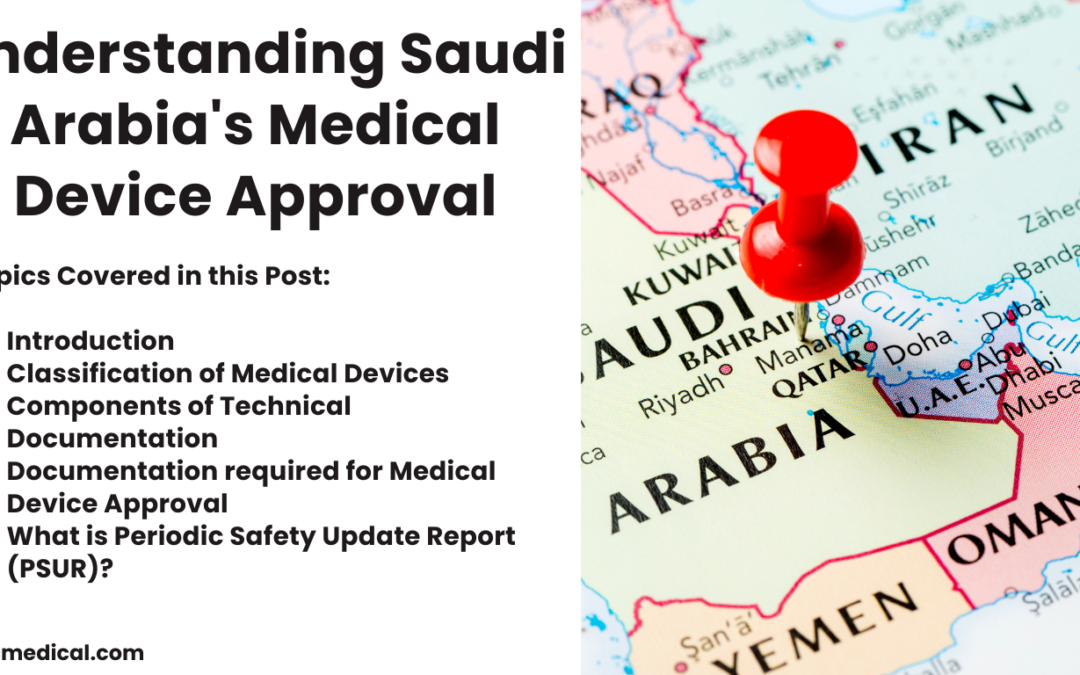Introduction
The Saudi Arabian Medical device registration and approval is governed by the Saudi Food and Drug Authority, also known as the SFDA. The procedure for the introduction of a medical device in the Saudi Arabian market is called Medical Device Marketing Authorization (MDMA).
SFDA has published a guidance document, MDS-REQ-001, on Requirements for Medical Device Marketing Authorization. This guidance provides detailed information on the authorization process.
Saudi Arabian Medical Device Classification
SFDA classifies medical devices into four classes: Class A, B, C & D. Medical device classification is done as per Annex 5 of MDS-REQ-001. The medical devices are classified based on 22 rules, while the in-vitro diagnostic devices are classified based on seven rules.
Any foreign manufacturer willing to market their product in the Kingdom of Saudi Arabia (KSA) must appoint a Saudi Arabia Authorized Representative (AR). This AR will carry out all the registration formalities on behalf of the legal manufacturer.
The AR must possess an Authorized Representative License to conduct the registration activities effectively.
What is GHAD System?
The SFDA has switched to an electronic system for document submission, called GHAD System. Local and Foreign manufacturers, via an AR, should submit their application electronically in the GHAD System.
The manufacturer shall prepare a Technical Documentation, comply with and confirm the Essential Principles of Safety and Performance and maintain an effective Quality Management System (QMS).
4 Components of Saudi Arabian Technical Documentation
Other essential components of Saudi Arabian Technical Documentation will include:
1. Device Description & Specification
2. Labels and IFUs
3. Risk Management File
4. Post Market Surveillance documents
SFDA can request more information if needed which should be provided to them within ten days of request.
In addition to the above-mentioned documents, clinical evaluation is another important documentation in the Technical File. Adequate clinical evaluation studies should be carried out to prove the safety and efficacy of the medical device.
Performance evaluation studies should be carried out demonstrating scientific validity, and clinical and analytical performance. A strong clinical evaluation report, plan, and post-market clinical follow-up should support the technical file.
Post Market Surveillance
Post Market Surveillance Report is required to be submitted by manufacturers of Class A devices. This report should be generated when necessary or when requested by the SFDA. Manufacturers of Class B, C and D devices should generate a Periodic Safety Update Report (PSUR).
A PSUR should be generated annually for Class C and D devices and once every two years for Class B devices. Class D and Implantable devices should produce Summary of Safety and Clinical Performance documentation.
The SFDA also accepts electronic Instructions for Use (e-IFU). The manufacturers should provide adequate risk assessment documentation related to the e-IFU. The risk assessment should be updated in conjunction with the post-marketing activities.
For devices with a fixed expiry date, the e-IFU should be maintained for at least two years after the end of the expiry date of the last produced device. For devices with no expiry, the e-IFU should be maintained for 15 years after the previous device has been manufactured.
About OMC Medical
OMC Medical is primarily based in the UK with offices around the globe offering regulatory support to medical device manufacturers; Offering assistance starting from medical device design requirements in accordance to the relevant applicable standards, obtain relevant MoH certification or listings, establishing your devices in a new market, keep product licenses up to date until the product is End of Service (EOS).
